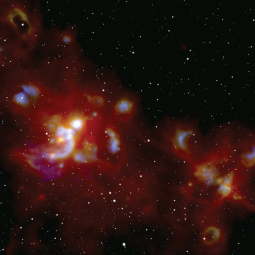By W. Lim, J. De Buizer, R. Klein, and J. Schmelz (USRA)
Paper:
Surveying the Giant HII Regions of the Milky Way with SOFIA. I. W51A
Lim and De Buizer 2019, ApJ, 873, 51.
Massive stars play a central role in the shaping of our galaxy, but we are literally in the dark about the details of how they form. SOFIA’s infrared vision peered into the heart of W51 , the relatively nearby giant star forming region, revealing the cosmic fireworks sparked by massive stars. These mid-infrared observations characterized dozens of young stars, many identified for the first time, and were essential in understanding their early evolutionary states. This study finds that SOFIA’s high spatial resolution is a powerful tool to trace deeply embedded massive young stellar objects.
Massive stars like these are rare — less than one percent of all stars. They emit caustic levels of radiation and generate powerful stellar winds that affect the formation of stellar siblings in the natal cloud. Lower mass stars like the sun have much quieter and humbler origins. So many of these stars are available for study that astronomers understand their birth properties much more thoroughly than the rare massive counterparts.
Across the universe, massive stars, which are more than ten times more massive than our sun and up to a million times more luminous, are playing a critical role in the evolution of our galaxy. They act as a heat source for the interstellar medium and enrich it with heavy elements. Despite their importance, astronomers have a relatively poor understanding of the formation and evolution mechanisms of massive stars. This is not only because they are rare and far away (typically thousands of light-years), but also because they are deeply embedded in dense interstellar gas and dust clouds at their early evolutionary stages. To observe young massive stars, thus, requires mid-infrared or longer wavelengths and relatively high angular resolution.
The F aint O bject infra R ed CA mera for the S OFIA T elescope, FORCAST, was used to peer into the turbulent stellar nursery and uncovered 47 compact objects. In order to understand the nature of these objects, researchers combined the SOFIA observations with data from NASA’s Spitzer Space Telescope and Herschel Space Observatory . The resulting spectral energy distributions (SEDs) reveal the brightness over a large wavelength range. The SOFIA-FORCAST 20 and 37μm observations were essential for this analysis since the fluxes at these wavelengths could include contributions from both the central star and the envelope from which it forms.
The SEDs have been compared with predictions from massive star formation models to estimate physical properties. The majority (41 out of the 47) are likely to be massive young stellar objects, many of which are identified as such for the first time in this work. Close to half of the massive young stellar objects do not have detectable radio continuum emission at centimeter wavelengths. This implies a very young state of formation since the stars have not yet developed a surrounding zone of ionized gas.
One of the compact objects was surprisingly bright across all wavelengths. Modeling of these data indicates that it may be exceptionally large, with the equivalent mass of 100 suns. If future observations confirm that it is indeed a single, colossal star, rather than multiple stellar siblings clustered together, it would be one of the most massive forming stars in our galaxy.
Another part of the study was the quantitative analysis of the star formation history in W51A, which confirmed and improved upon earlier results. The luminosity-to-mass ratio, which traces the evolutionary state, was derived for several regions to estimate their relative ages. The oldest, most evolved area is in the upper left of the image. The complex in the lower right is significantly younger, but the youngest region is located near the center of the image. There are indications that the collision of interstellar clouds at this location caused this most recent episode of star formation.
SOFIA is a Boeing 747SP jetliner modified to carry a 106-inch diameter telescope. It is a joint project of NASA and the German Aerospace Center, DLR. NASA’s Ames Research Center in California’s Silicon Valley manages the SOFIA program, science and mission operations in cooperation with the Universities Space Research Association (USRA) headquartered in Columbia, Maryland, and the German SOFIA Institute (DSI) at the University of Stuttgart. The aircraft is maintained and operated from NASA’s Armstrong Flight Research Center Hangar 703, in Palmdale, California.
